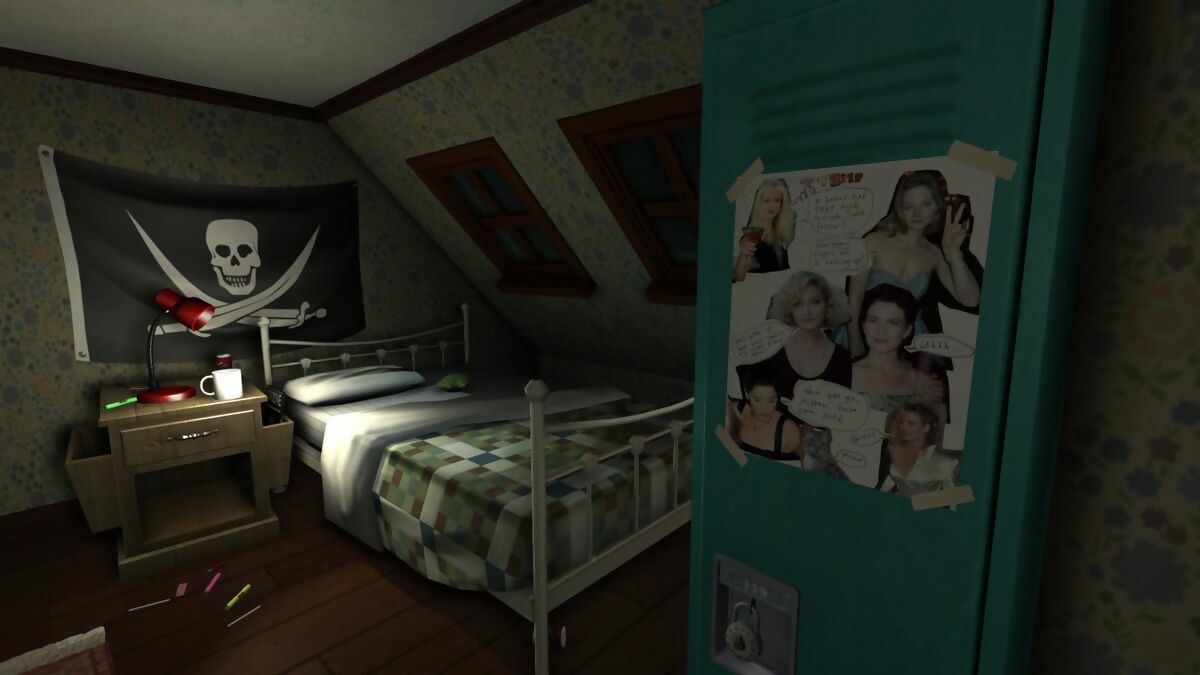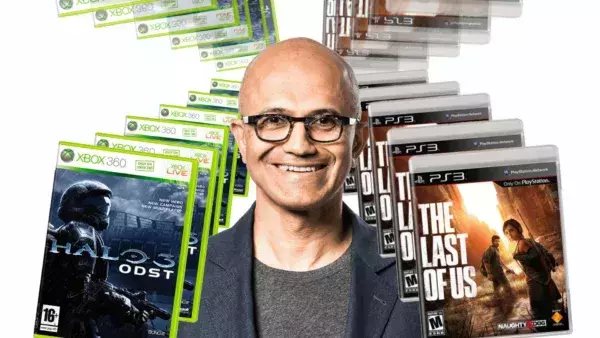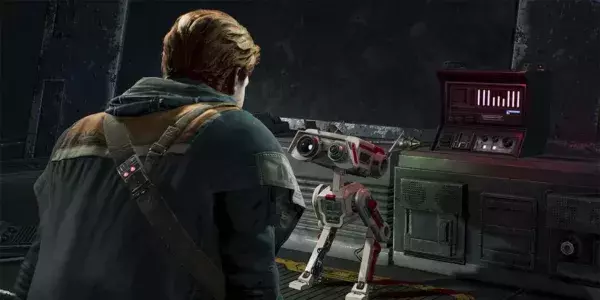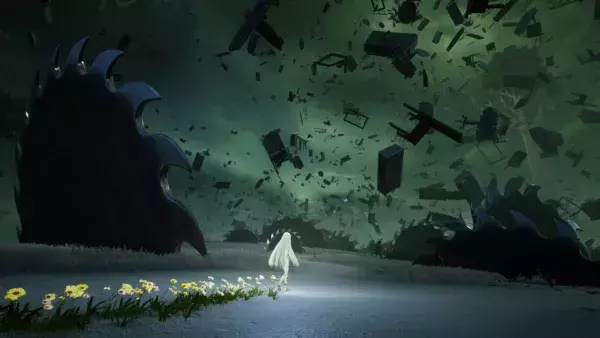
While at a wedding a few weeks ago, idly chatting about video games with a fellow guest, I was asked a question that surprised me in just how astute it was. “Does the technology you work with inform the kinds of narratives you can write?”
It was a wonderfully in-depth question and the answer for those who haven’t had the misfortune of making a game themselves is: yes. A yes so emphatic it could be written out in five-foot letters and it still wouldn’t convey how intertwined the two elements are. Coming from Fullbright, a small independent studio in Oregon that focuses almost exclusively on storytelling and character pieces, it’s not just a question about game development, it’s the ultimate question.
Making a game, from early preproduction to the last frantic, bleary hours, is all about picking the battles you have a chance at winning. And choosing which elements to push to the forefront while sweeping others under the rug is an everyday tug of war.
Do I make the doors swing on hinges, for instance, or is there a convincing reason I can make them pocket doors instead? Can I completely nuke doors altogether and put a hall in the same space without sacrificing any of the flow or aesthetics? It’s not a big deal on my end – as an environment artist a door is, in its simplest form, a tall rectangular box – but for a programmer and level designer it’s the difference between a player getting pinned into a corner, or forcing the door to awkwardly swing in both directions.
It means strange screen jitters as the camera figures out how to navigate around it, or setting up physics objects to respond to being smacked by an opening door. We have a meeting next week and the only subject we’re discussing is doors. Including seemingly innocuous, everyday elements like these can have massive implications on your game.
When I consider the last few years of walking simulators (stroll-playing games, first-person snoopers, exploration games – take your pick), they all share a sense of loneliness that stems from both technological limitations and sticking to a project’s financial scope. Firewatch, Gone Home, Dear Esther, Everybody’s Gone to the Rapture, Tacoma – at their core they face a similar conundrum: how do I make a game without or with minimally detailed characters, and what does it mean for the story and world if I do?
Why wouldn’t you want characters in your game? Honestly, I would love to, and some of my favourite moments from the games I’ve played include NPC characters, but making a game with fully animated characters, or even just a single animated player character, changes absolutely everything, and this is best illustrated through mirrors.

There’s a good reason why Gone Home’s world is free from reflective surfaces.
Dirty mirrors
Mirrors and reflective surfaces can, like doors, be a whole to-do. They’re a simple in-world object that creates a cascade of smaller problems. If you have a mirror in your bathroom, it has to reflect you, the player – and presumably you as a player are controlling a model of some sort, which means the developers have to hire a talented character artist to sculpt that model, then retopologize/optimise it so it can deform in a convincing way when it moves. Then a rigger or technical artist comes along to put in a skeleton (an animatable framework) so it can actually be moved about, then an animator is hired to create a series of animations and all the facial expressions, and by the time you’ve done all that and hired or contracted all those people and done all that work, your indie studio is out of money and you all have to go back to working on Margaritaville tie-in games for Facebook, which is absolutely not a part of my career path whatsoever.
Besides sheer difficulty and cost, there are a multitude of other reasons you might opt to exclude something from your project. In the Gone Home house I’d originally modelled a pair of flip-flops and placed them in the closet, but as the August deadline drew closer and my sleeping pattern grew more and more erratic, creating additional shoe models become impossible within the allotted time. I could place the flip-flops around the house, sure, but they would be the only genre of shoe in the entire home, and the narrative implications of that – that the family was a beachy party time family who spurned the idea of boots or running shoes – ran counter to the thoughtful atmosphere we were trying to cultivate. The solution was straightforward and brutal: we deleted all flip-flops from the house and the game shipped with absolutely no footwear whatsoever.
(On a related note, if you find yourself pausing at the use of ‘running shoes and flip-flops’, regional terms for assets are something I regularly think about when naming game assets. As a Canadian working alongside an American team, I would often rename objects to fit a different regional standard. The number of Us and REs I’ve left out of named assets is in the tens of billions by now, except for one notable case where an errant ‘u’ caused a lore change: the Gone Home mom Janice was edited to be a Canadian living abroad and we included a citizenship document in the basement.)
While on the subject of Gone Home, the player, in the completely non-extant shoes of Katie, is depicted as – well, nothing. Behind the player camera she’s simply an invisible capsule collider that moves through the house picking up objects. And by picking up objects I mean levitating them in front of her. The girl’s got no hands.
In Tacoma we pushed harder, and the main player character Amy has feet, and legs, hands, and everything you might want from a person except a head. She was modelled in this decapitated way so that a camera could take its place. When you control her you can look down and see Amy stepping onto things, see her opening doors and using American Sign Language with actual moving fingers, but if Amy were to look in a mirror it would be a horror show.

Tacoma’s Amy: everything you could want from a person – except a head.
Clocks, both digital and analogue, present another problem for level designers and environment artists to puzzle out. In all the games I’ve worked on, we either haven’t included them, or try to present an elegant narrative reason for them being out of commission, like a thunderstorm that’s knocked the power out and caused all digital clocks to flash 12:00, or a battery running low that causes analogue clock hands to tick back and forth endlessly.
They’d be doable enough to implement, I’m sure, but adding a working clock in world creates a number of distracting questions that we don’t really care to answer, with the biggest being lighting. A developer would have to tie the time of day to the scene’s lighting scheme, which would have to change over time and possibly wipe out any of the artfully arranged lighting cues. Since we’re usually more interested in creating a considered narrative moment than being rigidly faithful to what time of day it is, by banishing all clocks from an environment you can effectively freeze a moment in time. Time is only implied in Fullbright games.
The horror of lifts
I’ve had the good fortune of never having worked on a game that required enclosed elevators, but I’ve been told they’re up there with doors in the pantheon of pain. Putting a player inside a small box with a camera and then moving that geometry up and down in the world is one of those things that seems straightforward on its face, but, like a single pull-up, can be unexpectedly tough.
Rococo’s a no-no
Hopping from the difficulties of single assets to something much grander in scale, art direction is hugely influenced by the tools and technology available. I suspect the reason you don’t see many game stories set in rococo period Bavaria or art nouveau Paris is also down to technology. Polygons can be expensive in great numbers and the more organic and flowing a model is, the more expensive it’ll be. Rococo and art styles akin to it are all curves and ornate detail, flowers and foliage, while art deco, with its repeating geometric elements and love of sharp corners, lends itself to working with 3D modelling programs in the way the others don’t. BioShock and Grim Fandango hit on something beautiful when they chose the architecture that they did, but they also chose something flattering to their tools.
If there’s a through line here, at least in the games I’ve worked on, it’s artful, hopefully invisible avoidance, and trying not create situations you can’t pay off in a satisfying way, either from a visual point of view or something more mechanical. If you only have limited resources, try not to include doors a player can’t open, or taps that don’t turn on, unless you have a reason for it. If you have a button, it should be pressable; if you have a microwave and a player can push objects inside it, why can’t they turn it on and melt things?
These are questions that are important to me for working on story-focused games, but not every game will or even should be dwelling on things like flip-flops and microwave mechanics. I don’t question the way the doors open in Overwatch because I’m more concerned with other things, like trying not to fall off the edge while playing Tracer or sobbing when I play Mercy.
(In Gone Home, we used both pocket doors and standard hinged doors. Despite the house in the setting being a Victorian manor and a perfectly plausible location to put sliding pocket doors, the thought didn’t occur to me until halfway through production – which is why you only find them in the last half of the game.)

Even the way doors swing or slide can be an important consideration when developing an indie game.
While it didn’t strictly affect the narrative of our games, in both Tacoma and Gone Home the team ran into the problem of objects falling through the world. Thin items like books and pencils, when tossed by the player, would often vanish beneath the floorboards, never to be seen again. Falling through the world is hardly a new bug in games, and we eventually tackled it by making the collision thicker, but I wish we’d solved it as elegantly as the Dragon Age: Inquisition team, who created a pie-owl-creature in a top hat, and when and if the player fell through the world, they were suddenly faced with a pastry monster while calliope music played.
With each game being so different from one another, I’m always reluctant about offering anything like black and white advice, but based on personal experience, the battles you choose to fight as a developer should be the ones that best serve your game. If you truly want a particular element, there are workarounds and solutions to getting there and it’s just a matter of digging in or asking around to see if others have dealt with it before. If you wanted to include a mirror, maybe it would be fogged over, cracked, dirty, or fallen on the ground. Maybe you’d have to write your entire story from the perspective of a vampire, or maybe you decide characters are something you want to invest in and so, instead of sidestepping the issue, you drop that character modeller a line.
Current technology does detour us when it comes to the kind of stories we’re able to tell, but it doesn’t cut us off entirely. And, as most people with creative jobs or hobbies likely know all too well, borders and limitations force a person to really think about what they want out of their project and how thoughtful they can be when they approach it, and perhaps makes them better for it.





